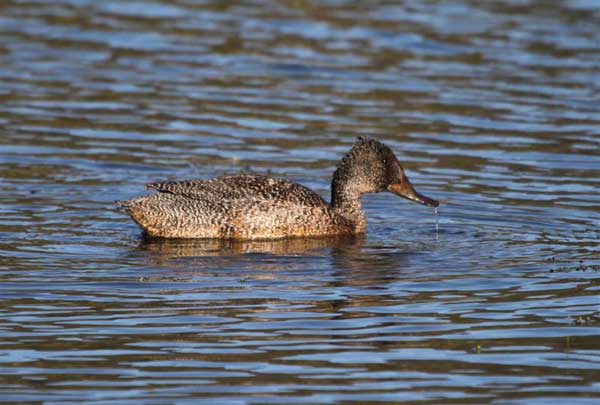
I put my twitcher’s hat on recently and went in search of one of Australia’s rarest ducks, and certainly the rarest to be seen in Tasmanian waters.
The birding wires were running hot at the end of March with the sighting of four freckled ducks at Gould’s Lagoon at Austins Ferry.
My twitching days are long behind me and I don’t usually go in search of birds merely to “tick” in a notebook, the first for a city or state list, or even country.
“Plenty of freckled ducks on the mainland,” I would normally say to myself, even though I had searched for these beautiful birds when I lived in Queensland and never found them. And here they were, just about 20 kilometres from my home.
It just so happened the day before I learned of the freckled ducks’ arrival I had read a report in the Melbourne Age of several hundred ducks being shot illegally on a property in north-western Victoria on the opening of the duck-hunting season.
Among 760 ducks and non-game birds shot had been rare and protected species, including freckled ducks and Australasian grebes.
The freckled duck is arguablyAustralia’s rarest, endemic duck, with an estimated population of less than 20,000. They breed in the areas around the Lake Eyre Basin, western NSW and south-west Queensland, often after flooding. After successful breeding years – yhe Lake Eyre region has been in flood in recent years – they move out of their breeding areas as the interior dries, seeking better conditions. If drought persists they irrupt into coastal areas and, consulting the excellent Birds in Tasmania website, I discovered that there had been many sightings of freckled duck around coastal areas of mainland states in recent months. Some of these birds had obviously reached Tasmania although the four seen at Austins Ferry probably doubled the total number that had been recorded inTasmania over the years.
Unfortunately, these irruptions often coincide with the wild-fowl shooting season and many are shot. They are wholly protected throughout Australia but this is no guarantee they would be spared the buckshot, or duckshot, as evidenced by the report in the Age.
When I set off for Gould Lagoon I had little expectation of actually finding the birds, although Els Wakefield, who compiles Tasmanian rare species reports for BirdLife Australia magazine, told me they could be easily seen by the road that borders the reserve when she first alerted me to their presence. The report though was a day old and I remembered an earlier rare twitching foray to Gretna one chilly winter’s day to find another mainland species, pink-eared ducks, that never materialised.
I am happy to say I found the four freckled ducks easily. They were roosting amid a patch of reeds with an obscured view but then two of the birds obliged by taking to the water. They really were stunningly beautiful birds, if not showy like some other duck species that attract the birder’s eye. As their name suggests, freckled ducks have a freckled pattern over their entire grey-brown bodies - they are also called oatmeal ducks – and are also distinguished by a slightly crested head and a bill in the shape of a dish. In the breeding season the males have a bright red area between nostrils and forehead on the upper mandible. And I could discern that two of the birds had traces of this, so they were males of course.
The Birds of Tasmania website informs me that these dabbling ducks use a feeding method called “suzzling”. The word refers to the action of filter feeding, where the duck sucks particles into the bill tip and expels water near the bill base, as it feeds on seeds and small crustaceans. The ducks on Goulds Lagoon noticeably ‘‘dribbled’’ as they fed, or should I say suzzled.
* The Birds of Tasmania website carries pictures of rare birds visiting Tasmania – and many of the more common ones – and another source of information on visiting birds is Birdline Tasmania where sightings can be reported.